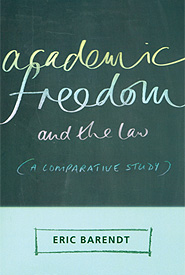
Eric Barendt. Oxford, UK & Portland, OR: Hart Publishing, 2010; 331 pp; ISBN: 978-1-84113-694-3, paper $80 US.
By Dwight Newman
Academic freedom is a value at the heart of the academic enterprise. Some invoke it as a shield in defence of unpopular but important scholarly activity while others may occasionally unsheath it as a sword to swing at various targets. But a thorough understanding of academic freedom can support and sustain academia and its intellectual role in society. Misunderstanding of academic freedom lends succour to those who challenge academia’s role or distort discussions in potentially dangerous ways.
Various works over the years have helped describe and delimit the nature of academic freedom. These include statements of academic associations, studies on the history of academic freedom and works on the purposes and nature of the value. Yet, less often is there extended attention to international comparison of legal recognitions of academic freedom, which is largely absent in the Canadian context — apart from a few phrases in Supreme Court of Canada judgments on other issues and, obviously, some collective agreement provisions — but present in different ways in other countries.
Academic Freedom and the Law fills this gap. It deals with comparative legal protections of academic freedom in an accessible and engaging manner that will be of interest to academics both inside and outside law faculties.
The book focuses on Germany, the United States, and the United Kingdom, illustrating effectively their different legal approaches to academic freedom. Germany has a written provision in its constitutional Basic Law protecting a broader idea of scientific freedom and teaching freedom. American judges have developed constitutional case law on academic freedom as a dimension of First Amendment rights. And the United Kingdom added a statutory protection for academic freedom when tenure was eliminated in 1988. In each case, Eric Barendt details the provisions and subsequent interpretation of them.
Academic freedom, though, is not a homogenous concept. More interesting for those thinking about the scope of academic freedom is the book’s discussion of these different countries’ approaches to different facets of academic freedom, some of which can come into tension with each other. The book distinguishes such dimensions of individual scholars’ academic freedom as freedom of research and publication, intramural expression concerning decisions within an academic institution, and protections of extramural expression on matters of public interest that may diverge from simple freedom of expression claims.
At the same time, academic freedom can have important institutional dimensions, protecting the autonomy of academic institutions from certain external pressures, but institutional freedoms will sometimes be in tension with individual scholars’ claims. Barendt invites his reader to engage with the genuine complexity of academic freedom, interrelationships between different dimensions of the issues, and the responsibilities inherent in academic freedom.
Important dimensions of academic freedom in specific circumstances are those that respond to the contemporary threats to the values academic freedom protects. Later chapters of Barendt’s book are timely in dealing with potential threats to academic freedom from such sources as research ethics requirements, intellectual property rights, university-industry collaboration, privacy legislation, anti-terrorism rules, and so on.
His discussion is enlivened with examples, with Canada coming off somewhat badly in light of the University of Toronto’s conduct in the Nancy Olivieri and David Healy cases serving as two of Barendt’s key examples of certain forms of university collaboration with industry causing interference with academic freedom.
Barendt’s discussion of these different contexts is sophisticated and informative and will surely invite awareness of different issues than any one academic will have been exposed to in his or her own disciplinary context. At the same time, one limit on this application part of the book is that after large parts focused on legal protections of academic freedom more generally, the focus here is on specifically legal interferences with academic freedom.
The author does not discuss at any length policies, including the structuring of research grants criteria or assessment exercises, that may have coercive effects on academic freedom but are not expressed in the form of actual legal restrictions. At least some such threats warrant discussion. This would enrich the analysis of the legal protections that might apply against them. That said, the book has no shortage of matters to examine and has already rewarded well the reader who has followed the argument.
A key underlying argument of the book — and an important reason to take note of a book on the law of academic freedom specifically — is that different forms of legal protections of academic freedom have different consequences in the context of specific threats or specific cases. Those contemplating proposed legal protections of academic freedom or negotiating collective agreements having articles on academic freedom would do well to consider seriously Barendt’s discussion of different implications of different versions or forms of protection.
At the same time, Barendt’s book will be of interest to academics generally and perhaps especially those newer to the academy who would benefit from exposure to the range of academic freedom issues the academy has faced over time, some different ways of approaching the definition and implementation of protections for academic freedom, and a generally moderate, sophisticated account of academic freedom in all of its multi-faceted complexity.
---------------------------------------------------------------
Dwight Newman is professor of law at the University of Saskatchewan.